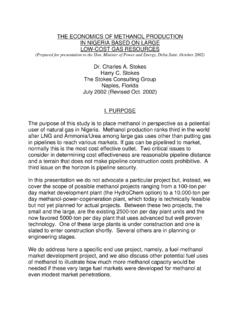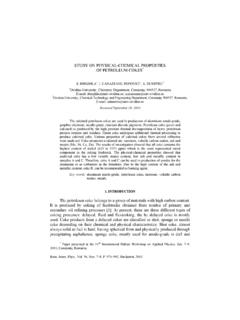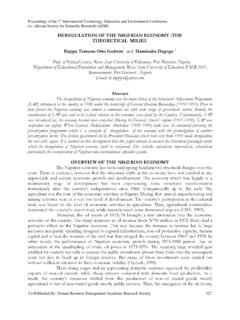Transcription of PETROLEUM ECONOMICS A. Clô Dept. of Economic Sciences ...
1 PETROLEUM ENGINEERING - PETROLEUM ECONOMICS - A. Cl and L. Orlandi PETROLEUM ECONOMICS . A. Cl . dept . of Economic Sciences , University of Bologna, Italy L. Orlandi RIE Srl, Energetic and Industrial Research, Bologna, Italy Keywords: PETROLEUM , crude oil, energy, demand, supply, price, elasticity, risk, capital intensity, investment, E&P industry, competition, stability, growth, oil companies, vertical integration, internationalization, concentration, coordination, pricing policies, posted prices, spot markets, futures markets, newcomers, OPEC, structural determinants, Economic growth, spare capacity, financial determinants, recession, TE SS.
2 Investment's paralysis. S. Contents R. AP L. 1. Basic conditions for PETROLEUM ECONOMICS H O. High Capital Intensity and Risk Factor Level and Structure of Oil Production Costs C E. Economies of Scale, Interdependences, Specificity The Time Factor . E O . The Demand Function The Energy Demand: Qualitative Specificities The Oil Demand: General Lines 2. Market structure and price dynamics in twentieth century PL C. From The Pioneers To The American Oil Industry: 1859-1900. From American to International Industry: 1900-1940. M ES. Concentration and Coordination: 1940-1970. Inertial Stability and Evolutionary Processes Newcomers on the Oil Market SA N.
3 Administered Prices and Market Prices The Birth of OPEC. U. Towards a New Equilibrium 3. The new oil era: an unprecedented price escalation Structural Determinants The Financial Determinants World Recession in the Second Half of 2008: Back on Fundamentals OPEC Policies and the Risks of Cheap Oil Acknowledgments Glossary Bibliography Biographical Sketches Summary The analysis follows the historical development, going over the various stages taking place since the beginnings of the oil industry up to nowadays. The reason is that each of Encyclopedia of Life Support Systems (EOLSS).
4 PETROLEUM ENGINEERING - PETROLEUM ECONOMICS - A. Cl and L. Orlandi these shows structural characteristics, relations of strength, Economic and political dynamics which cannot be immediately attributed to the traditional life cycle of an industry and which indeed can no longer be repeated. There are two aspects which run horizontally through these historical dynamics. The first is the way in which the basic conditions of the oil economy have influenced the behavior of the various players and in particular of the oil companies, according to the specific external context in which they were operating.
5 The second aspect is the way the companies have attempted to respond to the challenge that has through the whole history of the oil industry: how to reconcile (short-term). competition with (long-term) stability of the markets. The initial phases, characterized by ruinous competition followed by close oligopolistic coordination, were followed by TE SS. the disappearance of unequal relations of strength between producer states and companies that led to the predominance in international markets of conditions of broad, S. thought not perfect, competition. R. AP L. The last chapter is focused on the recent market dynamics characterized by two opposite H O.
6 Phases: 1) a fast and unexpected escalation of oil prices, mainly driven by the financial transactions on futures markets implemented by non-commercial operators; 2) a deep C E. and fast drop in prices driven by word Economic recession: this condition born in US. and then spread in a lot of country around the world. E O . In this mentioned last period, the consequent collapse of oil demand, due to the Economic recession, caused an oversupply condition on the oil market with bearish effects on oil prices. This dynamic hides a potential and dangerous bullish factor: the PL C.
7 Investment's paralysis. The oil price fall by 100 Dollars per barrel in 4 months (in 2008) and the international credit crunch are writing off investment along the whole oil M ES. chain, especially in the upstream activities. The low level of oil prices and the restriction of credit market access forced the oil SA N. companies to review, postpone and cancel several projects for being no longer profitable in this new business environment. In addition to this renewed reluctance to U. invest, a new element of pressure appears on the supply side: the fast and high decline rates in several non-OPEC oilfields.
8 Are these ones warning signals of a new oil prices escalation? 1. Basic Conditions for PETROLEUM ECONOMICS In order to understand the market dynamics, the company strategies, the policies and the price trends of the PETROLEUM economy, we need to refer to a number of important basic conditions . Each of these has a different influence according to the aspect that we intend to investigate, and changes in time according to technological developments and market situations. Only a thorough analysis will help us to isolate the effect of each individual condition as well as, more importantly for analytical purposes, their combined effect.
9 The following table summarizes the basic conditions that in PETROLEUM ECONOMICS are the most relevant Encyclopedia of Life Support Systems (EOLSS). PETROLEUM ENGINEERING - PETROLEUM ECONOMICS - A. Cl and L. Orlandi as regards the offer and the demand. Basic Economic conditions of the oil industry SUPPLY DEMAND. High capital intensity and high risk Low price elasticity High scale and scope economies High income elasticity Increasing plant specificity Differentiated elasticity Low price elasticity Cross elasticity Table 1. Basic Economic conditions of the oil industry TE SS.
10 Before analyzing these conditions individually, we should first call to mind the S. sequence of events into which the oil industry is divided: 1) mining activity, including all those activities from the first geophysical prospecting up to the production, R. AP L. collection and loading of the oil; 2) marketing of the oil and/or its derivatives; 3). H O. transport, from the production areas to the areas of oil refining and then to the areas of consumption of its derivatives; 4) refining of the oil; 5) distribution of its derivatives. C E. As we will see in the chapters to follow, motivations of Economic convenience and strategic opportunity have compelled the majority of firms to operate in all phases of the E O.















